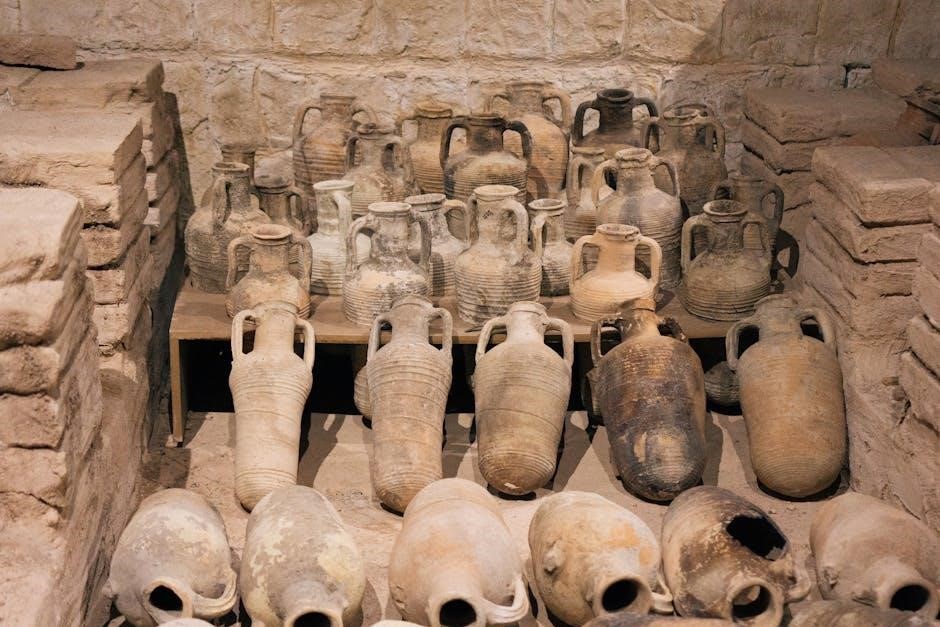The Honeywell Vision Pro 8000 operating manual provides a comprehensive guide for installing‚ programming‚ and maintaining this advanced touchscreen thermostat‚ ensuring optimal performance and energy efficiency.
Overview of the Thermostat
The Honeywell Vision Pro 8000 is a 7-Day programmable thermostat designed for universal system compatibility and precise comfort control. It features a touchscreen interface for easy navigation and programming‚ making it user-friendly. The thermostat supports various heating and cooling systems‚ including heat pumps and conventional systems‚ with options for dehumidification‚ humidification‚ and ventilation. It operates on a lithium battery and includes safety precautions‚ such as avoiding sharp instruments for touchscreen interaction. The Vision Pro 8000 is part of a series that includes models like TH8110‚ TH8320‚ and TH8321‚ each tailored for different system requirements. This thermostat is ideal for residential use‚ offering advanced features while maintaining energy efficiency and simplicity in operation.
Importance of Reading the Manual
Reading the Honeywell Vision Pro 8000 operating manual is essential for safe and effective use of the thermostat. It provides critical information on proper installation‚ operation‚ and maintenance to ensure optimal performance and energy efficiency. The manual highlights safety precautions‚ such as avoiding sharp instruments for touchscreen interaction and handling the lithium battery correctly. Additionally‚ it guides users through troubleshooting common issues and understanding advanced features like Wi-Fi connectivity and programmable schedules. By following the manual‚ users can prevent damage to the device‚ customize settings to their needs‚ and resolve problems without professional assistance. This ensures a seamless experience and maximizes the thermostat’s potential for precise comfort control and energy savings.
Key Features of the Vision Pro 8000
The Honeywell Vision Pro 8000 stands out with its 7-day programmable touchscreen interface‚ offering universal system compatibility for various HVAC configurations. It supports both conventional and heat pump systems‚ with options for dehumidification‚ humidification‚ and ventilation. The thermostat features precise temperature control‚ energy-saving schedules‚ and remote monitoring via Wi-Fi. Users can adjust settings‚ view outdoor conditions‚ and receive email alerts for system updates or issues. Its lithium battery ensures continuous operation‚ and the intuitive design makes programming effortless. These features combine to deliver enhanced comfort‚ energy efficiency‚ and smart home integration‚ making it a versatile solution for modern heating and cooling needs.

Installation and Setup
The Honeywell Vision Pro 8000 installation involves mounting the thermostat‚ connecting wires‚ and configuring basic settings. Ensure compatibility with your HVAC system for smooth operation.
Physical Installation of the Thermostat
Begin by turning off the power to your HVAC system at the circuit breaker. Remove the old thermostat and take note of the wire connections. Mount the Honeywell Vision Pro 8000 base plate to the wall using the provided screws‚ ensuring it is level. Carefully connect the wires to the appropriate terminals‚ matching the labels from your old thermostat. Gently snap the thermostat into place on the base plate until it clicks; Ensure all wires are securely connected and the device is properly seated. The large backlit display will illuminate once powered on. For a clean look‚ the thermostat can also be flush-mounted using the included spacer. Always follow safety precautions to avoid electrical shock or damage to the system.
Initial Setup and Configuration
After physically installing the thermostat‚ power it on and follow the on-screen prompts for initial setup. Select your system type (heating‚ cooling‚ or both) and choose the appropriate equipment type‚ such as a heat pump or furnace. Set your preferred temperature scale (Fahrenheit or Celsius) and adjust the date and time. Select your time zone and configure the HVAC fan settings‚ such as ‘Auto’ or ‘On.’ Choose the number of heating and cooling stages your system uses. Save your settings to complete the basic configuration. Test the system by adjusting the temperature to ensure it responds correctly. Refer to the manual for additional customization options to tailor the thermostat to your specific needs.
System Compatibility and Requirements
The Honeywell Vision Pro 8000 thermostat is designed to work with a wide range of HVAC systems‚ including conventional‚ heat pump‚ and dual-fuel systems. It supports up to 3 stages of heating and 2 stages of cooling‚ making it versatile for various home configurations. The thermostat requires a 24V AC power source and is compatible with most standard HVAC systems. A common wire (C-wire) is necessary for proper operation‚ especially for advanced features like Wi-Fi connectivity. Ensure your system meets the electrical requirements‚ such as voltage and current ratings‚ before installation. Compatibility with auxiliary devices‚ such as humidifiers or dehumidifiers‚ may require additional setup. Always verify system compatibility with the thermostat’s specifications to ensure optimal performance.

Programming the Thermostat
Programming the Honeywell Vision Pro 8000 allows for customized temperature schedules‚ optimizing comfort and energy efficiency. It offers flexible programming options to suit various lifestyles and preferences.
Basic Programming Steps
Start by accessing the thermostat’s menu and selecting the program option. Set the current date and time to ensure accurate scheduling. Choose the desired program type‚ such as a 7-day or 5-2 schedule. For each day‚ set the wake‚ leave‚ return‚ and sleep times‚ adjusting the temperature accordingly. Use the touchscreen to input temperatures and times. Save the program to apply the settings. The thermostat will automatically adjust based on your schedule. Ensure all settings are confirmed to avoid errors. This process allows for a seamless and energy-efficient temperature control experience tailored to your daily routine.
Advanced Programming Options
Access the advanced menu by pressing and holding the menu button for three seconds. Customize temperature settings for specific days or events. Enable geofencing to adjust temperatures based on your location. Set humidity control parameters if your system supports it. Program multiple temperature holds for extended periods. Adjust the thermostat’s recovery mode to pre-cool or pre-heat your space. Set smart alerts for system notifications‚ such as low battery or extreme temperatures. Define fan operation schedules for improved air circulation. These advanced features allow for tailored climate control‚ enhancing comfort and efficiency. Use the touchscreen to navigate through options and save custom settings for optimal performance.
Setting Energy-Saving Schedules
Create custom energy-saving schedules to optimize your heating and cooling usage. Use the touchscreen to set temperature adjustments for different times of the day or week. Select pre-set energy-saving templates or customize your own. Enable smart scheduling to automatically adjust temperatures when the house is unoccupied. The thermostat learns your usage patterns to suggest energy-efficient settings. Program setbacks for sleeping hours or when you’re away. Set humidity and fan schedules to maintain comfort while saving energy. Review and adjust schedules regularly to ensure they align with your lifestyle. Utilize the energy-saving mode to limit extreme temperature settings. These features help reduce energy consumption without compromising comfort‚ ensuring your system operates efficiently year-round.

Wi-Fi and Remote Access

Connect your Honeywell Vision Pro 8000 to Wi-Fi for remote monitoring and control through the Honeywell Home app. Access temperature adjustments and energy usage tracking from anywhere.
Connecting to Wi-Fi
To connect your Honeywell Vision Pro 8000 thermostat to Wi-Fi‚ navigate to the “Wi-Fi” option in the menu. Select your network from the list of available options and enter your password using the touchscreen keyboard. Ensure your router is compatible with 2.4 GHz networks‚ as the thermostat does not support 5 GHz. Once connected‚ a confirmation message will appear. If the network is not found‚ restart your router and thermostat. For password errors‚ re-enter the password carefully. A stable connection is essential for remote access and smart features. Refer to your router’s settings if issues persist.
Registering the Thermostat Online
To register your Honeywell Vision Pro 8000 thermostat online‚ visit the Honeywell Home website and create an account if you don’t already have one. Once logged in‚ navigate to the “Add Device” section and enter the thermostat’s registration code‚ which can be found in the packaging or under the settings menu. Follow the on-screen instructions to link your thermostat to your account. This process allows you to access advanced features‚ receive software updates‚ and monitor your system remotely. Ensure your thermostat is connected to Wi-Fi before attempting registration. If you encounter issues‚ refer to the troubleshooting guide or contact Honeywell support for assistance.
Remote Monitoring and Control
With the Honeywell Vision Pro 8000‚ users can monitor and control their thermostat remotely using the Honeywell Home app. This feature allows you to adjust temperature settings‚ view current conditions‚ and modify schedules from anywhere with an internet connection; Remote access is particularly useful for ensuring your home is at the perfect temperature when you arrive. The app also provides real-time notifications for system alerts‚ such as extreme temperature changes or filter maintenance reminders. To use remote monitoring and control‚ ensure your thermostat is connected to Wi-Fi and properly registered online. This functionality enhances convenience and energy efficiency‚ letting you manage your HVAC system seamlessly.

Advanced Features
The Honeywell Vision Pro 8000 offers advanced features like touchscreen navigation‚ smart home integration‚ and humidity control‚ enhancing comfort and energy efficiency seamlessly.
Touchscreen Operation and Navigation
The Honeywell Vision Pro 8000 features an intuitive touchscreen interface designed for easy navigation. Users can access temperature settings‚ schedules‚ and advanced features through a responsive display. The menu is organized into clear categories‚ allowing seamless adjustment of heating‚ cooling‚ and humidity levels. The touchscreen also supports swipe gestures for quick access to settings like energy-saving modes or system status. Brightness adjustment ensures visibility in varying light conditions‚ and the interface adapts to user preferences for a personalized experience. Navigation buttons and sliders simplify interactions‚ making it easy to customize comfort levels without complexity. This user-friendly design ensures efficient control over all thermostat functions‚ enhancing overall usability and convenience.
Adjusting Temperature and Humidity Settings
The Honeywell Vision Pro 8000 allows precise temperature and humidity adjustments for optimal comfort. Users can set preferred temperature levels manually or schedule them for automatic adjustments. The thermostat supports both heating and cooling modes‚ with options to switch between them seamlessly. Humidity control is integrated‚ enabling users to maintain desired moisture levels‚ especially in climates with extreme humidity. The touchscreen interface provides clear indicators for current temperature‚ target temperature‚ and humidity status. Adjustments can be made using the arrow keys or by entering specific values directly. Additionally‚ the thermostat offers energy-saving settings to balance comfort and efficiency‚ ensuring ideal indoor conditions while minimizing energy usage.
Smart Home Integration
The Honeywell Vision Pro 8000 seamlessly integrates with popular smart home systems‚ enhancing convenience and control. Compatibility with platforms like Samsung SmartThings and Amazon Alexa enables voice commands and centralized smart home management. Users can control the thermostat through dedicated apps or smart speakers‚ ensuring effortless adjustments. Geofencing technology allows the system to detect when you leave or arrive home‚ automatically optimizing temperature settings for energy efficiency. Smart alerts notify you of extreme temperature changes or system issues‚ ensuring your home remains comfortable and secure. This integration simplifies energy management and enhances overall smart home functionality‚ making it a versatile addition to any connected household.

Maintenance and Troubleshooting

Regular cleaning of the thermostat’s screen and sensors ensures accurate performance. Firmware updates maintain functionality‚ while resetting the device resolves common issues. Troubleshooting guides help identify and fix problems efficiently.

Regular Maintenance Tips
Regular maintenance ensures your Honeywell Vision Pro 8000 thermostat operates efficiently. Clean the touchscreen with a soft‚ dry cloth to prevent dust buildup. Check and replace batteries annually if applicable. Ensure the thermostat is level and securely mounted. Verify that vents and grilles are unobstructed for proper airflow. Update firmware periodically to access new features and improvements. Inspect wiring connections to avoid loose links. Test the thermostat’s responsiveness by adjusting settings manually. Schedule annual professional HVAC system checks to ensure compatibility and performance. By following these tips‚ you can extend the lifespan of your device and maintain optimal heating and cooling efficiency. Regular upkeep also reduces the risk of unexpected malfunctions.
Common Issues and Solutions
Common issues with the Honeywell Vision Pro 8000 include thermostat disconnections from Wi-Fi or incorrect temperature readings. If the thermostat loses Wi-Fi connection‚ restart it by turning it off and on. For temperature inaccuracies‚ ensure proper calibration in the settings. A blank or unresponsive screen may indicate low battery or power issues; replace batteries or check wiring. If the system fails to heat or cool‚ verify HVAC compatibility and ensure proper installation. For recurring issues‚ reset the thermostat to factory settings via the menu. Always refer to error codes displayed on the screen for specific troubleshooting guidance. Addressing these common problems promptly ensures uninterrupted performance and energy efficiency. Regular updates and proper installation can prevent many of these issues.
Updating Firmware
Updating the firmware of your Honeywell Vision Pro 8000 thermostat ensures access to the latest features‚ improvements‚ and bug fixes. To update‚ connect the thermostat to Wi-Fi and navigate to the settings menu. Select “About Thermostat” and choose “Update Firmware” if an update is available. The thermostat will download and install the new firmware automatically. Avoid turning off the device during the update to prevent potential issues. Firmware updates are typically released to enhance performance‚ add functionality‚ or improve compatibility with smart home systems. Always ensure your thermostat is connected to the internet before attempting an update. Regularly checking for updates helps maintain optimal performance and security. Firmware updates are optional but highly recommended for a seamless user experience.

Technical Specifications
The Honeywell Vision Pro 8000 features a 7-inch touchscreen display‚ 802.11n Wi-Fi connectivity‚ and compatibility with HVAC systems. It supports multi-stage heating and cooling systems. Built-in humidity control and geofencing capabilities enhance energy efficiency. The thermostat is designed for both residential and light commercial use‚ operating on 24V AC systems. It meets ENERGY STAR certification standards‚ ensuring energy-saving performance. The device weighs approximately 1 pound and measures 8.0 x 5.0 x 1.25 inches. Its high-resolution display ensures clear navigation and programming. Compatibility with smart home systems like Amazon Alexa and Google Assistant is also supported. Regular updates ensure optimal functionality. The thermostat requires a C-wire for power. It is designed to work with natural gas‚ oil‚ and electric HVAC systems. The Vision Pro 8000 operates within a temperature range of 32°F to 90°F (0°C to 32°C). It is UL certified for safety and performance. The thermostat is backed by a limited warranty‚ covering parts and labor for up to five years. Proper installation ensures accurate temperature control and system efficiency. The device supports up to six stages of heating and cooling. It also includes auxiliary heat control for heat pump systems. The Vision Pro 8000 is compatible with dual fuel systems‚ optimizing energy use. It supports remote sensors for accurate temperature readings. The thermostat is designed for easy integration with existing smart home setups. Energy usage history is tracked for up to 30 days. The device supports multiple languages‚ including English‚ Spanish‚ and French. Customizable lock screen options are available for added security. The thermostat includes a built-in real-time clock and automatic software update capabilities. It is designed to reduce energy consumption without compromising comfort. The Honeywell Vision Pro 8000 is a versatile and advanced thermostat designed for modern HVAC systems‚ offering superior performance and efficiency. It is widely regarded as one of the most reliable thermostats in its class. Regular firmware updates ensure the device remains up-to-date with the latest features and security patches. The thermostat is compatible with a variety of HVAC configurations‚ making it suitable for diverse heating and cooling needs. Its compact design allows for easy wall mounting‚ and the touchscreen interface provides intuitive control. The Honeywell Vision Pro 8000 is an excellent choice for homeowners seeking a smart‚ energy-efficient thermostat with advanced features. It is widely available through HVAC professionals and online retailers. The thermostat is covered by Honeywell’s customer support‚ offering assistance with installation‚ troubleshooting‚ and maintenance. It is a popular choice among smart home enthusiasts due to its seamless integration with other devices. The Honeywell Vision Pro 8000 continues to be a leading thermostat in the market‚ known for its reliability and innovative features. It is a valuable addition to any home seeking to optimize heating and cooling systems. The thermostat’s technical specifications make it a top choice for both new and existing HVAC installations. It is designed to last‚ with durable construction and high-quality components. The Honeywell Vision Pro 8000 is a testament to Honeywell’s commitment to innovation and customer satisfaction in home comfort solutions.
Model Variations and Compatibility
The Honeywell Vision Pro 8000 is available in multiple models‚ including the TH8110U1007 and TH8320U1008‚ catering to different HVAC system requirements. These models are designed to work seamlessly with various heating and cooling systems‚ including gas‚ oil‚ electric‚ and heat pumps. They are also compatible with dual-fuel and geothermal systems‚ ensuring versatility for diverse setups. The thermostat supports multi-stage systems‚ up to six stages of heating and cooling‚ and works with auxiliary heat systems. Compatibility extends to smart home platforms like Amazon Alexa and Google Assistant‚ enabling voice control and integration. The Vision Pro 8000 is suitable for both residential and light commercial applications‚ making it a flexible choice for different environments. Proper compatibility ensures optimal performance and energy efficiency.
Power and Battery Information
The Honeywell Vision Pro 8000 operates on a 24V AC power supply‚ requiring a common wire (C-wire) for consistent operation. It does not rely on replaceable batteries‚ ensuring uninterrupted functionality. The thermostat is designed to be energy-efficient‚ with low power consumption that meets Energy Star certification standards. Proper wiring is essential to avoid damage or malfunctions. If the system experiences a power outage‚ the thermostat retains its programming and settings thanks to its non-volatile memory. For systems without a C-wire‚ optional adapters or converters may be necessary to ensure compatibility. Always refer to the manual for specific wiring requirements to maintain optimal performance and safety. This ensures the thermostat operates efficiently and reliably in any setup.
Certifications and Compliance
The Honeywell Vision Pro 8000 thermostat is designed to meet strict industry standards and regulations. It is UL (Underwriters Laboratories) certified‚ ensuring safety and reliability in operation. The device also complies with Energy Star guidelines‚ promoting energy efficiency and environmental sustainability. Additionally‚ it adheres to FCC standards‚ minimizing electromagnetic interference. The thermostat is RoHS (Restriction of Hazardous Substances) compliant‚ free from hazardous materials like lead and mercury. These certifications ensure the product meets global safety‚ environmental‚ and performance requirements. Compliance with these standards guarantees users a reliable‚ eco-friendly‚ and safe smart thermostat experience. Always verify certifications when installing or upgrading to ensure adherence to local regulations and standards.
Mastering the Honeywell Vision Pro 8000 thermostat ensures optimal performance‚ energy efficiency‚ and comfort. Follow guidelines for seamless operation and enjoy its advanced‚ user-friendly features.
Final Tips for Optimal Use
To maximize the Honeywell Vision Pro 8000’s performance‚ regularly review and adjust your temperature schedules to match your lifestyle. Use the energy-saving features like geofencing and smart recovery to reduce energy waste. Ensure the thermostat is installed in an area with consistent temperatures‚ away from drafts or direct sunlight. Periodically check and replace the batteries if applicable‚ and keep the touchscreen clean for smooth operation. Explore the advanced settings to customize notifications and alerts for better monitoring. By following these tips‚ you can enhance comfort‚ efficiency‚ and overall satisfaction with your thermostat.
Resources for Further Assistance
For additional support with the Honeywell Vision Pro 8000‚ visit the official Honeywell website‚ which offers a comprehensive resource library‚ including user manuals‚ FAQs‚ and troubleshooting guides. Contact Honeywell’s customer support team directly via phone or email for personalized assistance. The Honeywell Home app also provides in-app support and tutorials. Furthermore‚ explore Honeywell’s official social media channels for updates and community advice. Manufacturer-authorized forums and discussion groups can offer peer-to-peer insights and solutions. Lastly‚ refer to the installation and technical specifications sections of this manual for detailed setup and compatibility information. These resources ensure you have everything needed to optimize your thermostat’s performance.

























































































